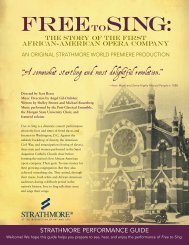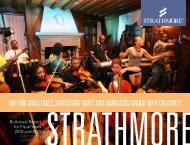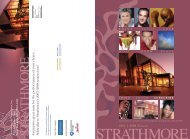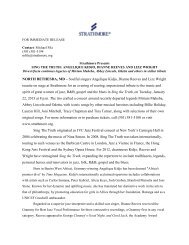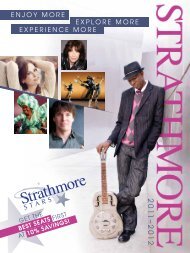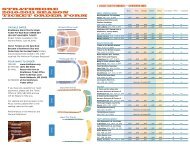Puppets Take Strathmore
Puppets Take Strathmore
Puppets Take Strathmore
You also want an ePaper? Increase the reach of your titles
YUMPU automatically turns print PDFs into web optimized ePapers that Google loves.
puppets<br />
<strong>Strathmore</strong> Education Guide<br />
June–August, 2013<br />
take<br />
<strong>Strathmore</strong><br />
“As an art form, puppetry has always relied on its ability to surprise people.”<br />
—Molly Ross, Artistic Director, Nana Projects<br />
STRATHMORE®
A Unique and<br />
<strong>Strathmore</strong> Performance Guide<br />
We’ve got puppets! Or perhaps they’ve<br />
got us—that’s the mysterious thing about puppetry.<br />
Sometimes puppets capture our imaginations in<br />
surprising ways. And if you look around, you’ll see that<br />
puppets not only serve as children’s entertainment<br />
but also as powerful tools for storytelling and for<br />
communicating ideas to people of all ages. The<br />
<strong>Puppets</strong> <strong>Take</strong> <strong>Strathmore</strong> festival will be exploring all<br />
that and more. This performance guide will help you<br />
get started.<br />
About <strong>Strathmore</strong><br />
Our Vision<br />
Transcendent moments that ignite the human spirit.<br />
Powerful Art Form<br />
When humans take any inanimate object and give it lifelike<br />
qualities—movement, feelings or expression—they<br />
have created a puppet. People have used puppets for<br />
thousands of years to tell stories, teach, entertain, protest,<br />
perform rituals, sell goods and more.<br />
Artists and performers turn to puppets for many reasons.<br />
<strong>Puppets</strong>:<br />
• can tell stories in interesting and surprising ways.<br />
• engage the audience’s imagination and sense of magic<br />
and mystery.<br />
• can be anything—from a plain fork to an elaborately<br />
painted wooden figure, from a simple shadow to a<br />
digital animation.<br />
• allow greater artistic freedom because they can be any<br />
size (huge, life-sized or small) and do things no human<br />
actor can do (like fly or shatter into multiple pieces and<br />
come back together).<br />
• are interdisciplinary, integrating performance with visual<br />
artistry such as painting, sculpture, woodwork, costume<br />
design, collage and more.<br />
Blue Sky Puppet Theatre<br />
Our Purpose/Mission<br />
<strong>Strathmore</strong> presents and produces exemplary visual and<br />
performing arts programs for diverse audiences; creates<br />
dynamic arts education experiences; and nurtures creative<br />
ideas and conversations that advance the future of the arts.<br />
Eliot Pfanstiehl, Chief Executive Officer<br />
Monica Jeffries Hazangeles, President<br />
Shelley Brown, Vice President, Artistic Director<br />
Georgina Javor, Director of Programming<br />
Lauren Campbell, Development and Education Manager<br />
Betty Scott, Education Program Coordinator<br />
Harriet Lesser, Curator<br />
Sam Younes, Visual Arts Assistant<br />
Special thanks to Colette Searls, Associate Professor of Theatre<br />
at the University of Maryland, Baltimore County (UMBC), for her<br />
help with developing this Education Guide; The Puppet Co. for<br />
background and co-producing the Puppet Slam; Molly Ross, Artistic<br />
Director of Nana Projects for background; and Blair Thomas, Artistic<br />
Director, Blair Thomas & Company for background.<br />
Puppetry frees artists to play with scale, like in this vast ocean<br />
scene from Eleventh Finger by Blue Sky Puppet Theatre.<br />
See it on July 20!<br />
22
Giving <strong>Puppets</strong> Life<br />
Bringing a puppet to life can be as easy as putting a sock<br />
on your hand and making it talk. But strong puppetry<br />
performances involve a great deal of skill, problem solving<br />
and imagination. Here are some of the main roles. Often<br />
one does many of the roles single-handedly.<br />
Blair Thomas<br />
& Company<br />
Writers begin the process by creating the story and<br />
characters.<br />
Directors coordinate how everything will look on<br />
stage and guide the overall vision.<br />
Nana Projects<br />
Puppeteer Blair Thomas performing a scene from Hard Headed Heart.<br />
See it on August 4!<br />
See the design work of Nana Projects during several events at<br />
<strong>Puppets</strong> <strong>Take</strong> <strong>Strathmore</strong>.<br />
Puppet Designers/Builders plan how<br />
the puppet will look and how it will work. They choose<br />
the materials—typically cloth, foam, wood, plastic, paper,<br />
leather or metal. They figure out the mechanics (such as<br />
how limbs will move) and construct the puppet so the<br />
puppeteer can operate it.<br />
Puppeteers operate and keep the audience’s<br />
attention on the puppets, creating big movements, such as<br />
running, somersaults or flying as well as small motions like<br />
breathing, crying, blinking, laughing and of course, talking.<br />
Audiences also play a role. For a puppet to have life,<br />
the audience must believe it does. Good puppeteering<br />
makes this easy.<br />
Cashore Marionettes<br />
Think about…<br />
Unlike actors who are limited<br />
by gender and appearance<br />
for the roles they can perform,<br />
puppeteers can play any<br />
role—any size animal or<br />
supernatural creature and any<br />
size, gender or age of human.<br />
“Puppetry is everywhere, but we don’t always notice it.”<br />
—Colette Searls, Associate Professor of Theatre at the University of Maryland, Baltimore County (UMBC)<br />
33
Type Casting<br />
<strong>Puppets</strong> represent humans, animals and spirits—they just need a shape and form and the ability to be<br />
moved by a human in order to do it. Here are the main types of puppets.<br />
Folkmanis Puppet Company<br />
Marionettes are usually designed as full human<br />
or animal figures and frequently have painted faces and<br />
detailed costumes. They are operated by moving strings<br />
attached to different parts of the body (sometimes with<br />
rods as well). Operators typically control marionettes from<br />
a platform above the stage or by standing over a<br />
miniature stage.<br />
Bring home a Folkmanis hand puppet from the <strong>Puppets</strong> <strong>Take</strong><br />
<strong>Strathmore</strong> festival, and create your own shows for friends and family!<br />
Hand <strong>Puppets</strong> are worn on and operated by the<br />
hand and fingers and often feature just heads and upper<br />
bodies. They are often made of fabric or foam, but can<br />
also be made of paper, wood, metal and other materials.<br />
Rod <strong>Puppets</strong> are operated by wood or metal rods<br />
attached to different parts of the body and sometimes<br />
have a central rod through the body.<br />
Blue Sky Puppet Theatre<br />
Jonathan Timmes<br />
Cashore Marionettes<br />
Nana Projects<br />
Don’t miss this scene from Cashore Marionettes’<br />
production of Simple Gifts on June 30!<br />
Jonathan Timmes Matt Cashore<br />
Molly Ross of Nana Projects performing a scene from<br />
Alonzo’s Lullaby. See it on July 27!<br />
Shadow <strong>Puppets</strong> are usually flat, rod-operated<br />
figures created to cast either a black or colored shadow<br />
when moved between a light source and a semitransparent<br />
screen.<br />
44<br />
Blue Sky Puppet Theatre founder Michael Cotter,<br />
featured throughout the festival, is a rod puppet master.
Object/Found-Object <strong>Puppets</strong> are<br />
created with everyday objects, for example, a toothbrush,<br />
a blanket or a hubcap.<br />
Bunraku (pronounced boon-RAH-koo) is an ancient<br />
Japanese-style of puppetry that traditionally involves a<br />
half- or three-quarter-size human body puppet operated<br />
by three puppeteers visible to the audience.<br />
These photos* of Bunraku, Object and<br />
Over-Life-Size puppetry are the work<br />
of Richard Termine, featured in the No<br />
Strings Attached fine art exhibit, June 22<br />
through August 17. Don’t miss it!<br />
Digital <strong>Puppets</strong> are relatively new and their<br />
definition is still under debate. Colette Searls, who teaches<br />
theater and researches puppetry at the University of<br />
Maryland Baltimore County (UMBC), describes digital<br />
puppetry as when an actor/puppeteer wears a motioncapture<br />
suit or uses a game-like controller to make a<br />
computer-generated animation come to life—a sort of “live<br />
cartoon” that can interact with other performers or even<br />
the audience in real time.<br />
Over-Life-Size <strong>Puppets</strong> range in size from a<br />
full body puppet that completely encloses the puppeteer<br />
like a costume, to huge puppets, like a parade balloon<br />
requiring multiple puppeteers.<br />
* Bunraku puppet image taken of The Mud Angels created by Luis de Robles Tentindo,<br />
part of Labapalooza! Mini Festival of New Puppet Theater from The Lab, presented<br />
by St. Ann’s Warehouse, Brooklyn, NY; photo: © 2009 Richard Termine. Object/Found<br />
Object puppet image taken of (2004) Muppet Video Workshop at the National Puppetry<br />
Conference; Eugene O’Neill Theater Center, Waterford, CT; photo: © 2004 Richard<br />
Termine. Over-Life-Size puppet image taken of Prometheus Within, conceived designed<br />
and directed by Theodora Skipitares, Skysaver Productions; April 2012 at The Ellen<br />
Stewart Theatre at La MaMa ETC; photo: © 2012 Richard Termine.<br />
Many see the character Gollum from The Lord of the Rings as a<br />
Digital Puppet, though such a designation is controversial with<br />
some traditional puppeteers.<br />
55
<strong>Puppets</strong> Grow Up<br />
in America<br />
Native American Puppetry<br />
Traditions<br />
Between the years of 300 and 600, Native American<br />
peoples used puppets in their ceremonies and rituals<br />
(and sometimes as toys). Hand and later rod puppets<br />
represented gods, demons and animals. Native Hawaiian<br />
tribes notably used hand puppets to make fun of politics<br />
and everyday problems.<br />
European Arrivals<br />
Hand, rod and marionette puppets—following closely the<br />
traditions established in England, France and Italy—were<br />
the stars of puppetry performances through the 1800s and<br />
early 1900s. Audiences watched them in theaters and as<br />
part of traveling vaudeville (variety) shows, such as Punch<br />
and Judy. These shows often used comedy and appealed<br />
to children, features that puppetry took to television<br />
starting in the 1940s.<br />
Kermit!<br />
Then came The Muppets. These beloved hand and rod<br />
puppets created by Jim Henson (who began his puppetry<br />
career on local television in Washington, D.C.) became<br />
stars of the still-running public television show Sesame<br />
Street, which debuted in 1969. Not only did they create a<br />
unique and internationally renowned American brand of<br />
puppetry, they started to open people’s eyes to puppets’<br />
greater potential as art and grown-up entertainment.<br />
To the Streets<br />
In 1963 in New York City, German immigrant Peter<br />
Schumann founded Bread and Puppet Theater (which later<br />
moved to Vermont), making puppets intended for outdoor<br />
performance and even political protests. You can see<br />
adaptations of this style at rallies like one for Occupy Wall<br />
Street held in New York City in 2011 that featured a Statue<br />
of Liberty puppet.<br />
Jim Henson and<br />
Kermit the Frog.<br />
Puppeteers and costumed actors perform a scene from<br />
the award-winning musical War Horse. The puppets,<br />
created by Adrian Kohler and Basil Jones of Handspring<br />
Puppet Company, earned a special Tony Award in 2011.<br />
Since the 1960s, puppets have become a popular tool<br />
for political protest, like this Statue of Liberty puppet<br />
from a rally of Occupy Wall Street protesters in 2011.<br />
A Puppet Renaissance?<br />
66<br />
American puppetry has continued to evolve. New<br />
generations of artists have been adapting puppetry to<br />
fit modern times and techniques (computer graphics, for<br />
example) and mixing and matching styles to create both<br />
small shows and blockbuster visual spectacles. The success<br />
of the 1997 Broadway musical The Lion King, featuring<br />
different styles of detailed puppets, and the success of<br />
shows after it like the hit play War Horse (which debuted on<br />
Broadway in 2011), showed that American audiences were<br />
embracing puppetry as a broader and more sophisticated<br />
art form. Puppetry has continued to expand its reach in<br />
live performance as well as film, where directors rely on<br />
innovation in creative effects that involve puppetry to bring<br />
more interesting and engaging creatures to life on screen.<br />
Some call puppetry’s new visibility on the cultural<br />
landscape a renaissance or rebirth. But it might just be<br />
another high point in puppetry’s ongoing process of<br />
reinventing itself—and advancing the art of storytelling..<br />
<strong>Puppets</strong> Around the World—For a tour of puppet<br />
history and traditions around the world, visit us online<br />
at www.strathmore.org/puppets.
Puppetry’s Gifts<br />
Puppetry has influenced American theater and culture—<br />
and life—sometimes in unexpected ways. Puppetry and its<br />
creative artists can take credit for:<br />
• inspiring other art forms, such as drama, dance and even<br />
the circus, to incorporate puppetry and greater visual<br />
elements.<br />
• attracting new generations of budding artists to study<br />
puppetry and the profession.<br />
• spurring new scholarly research in puppetry that can help<br />
us understand its impact on the arts and other fields.<br />
• providing a way to represent provocative ideas and<br />
promote change, such as through satiric puppet<br />
performances or political protests.<br />
Did you know… Beyond performance and protest,<br />
puppetry has become a valuable tool in therapeutic and<br />
educational settings, where puppets can be used to teach<br />
or help people discuss emotional and physical challenges.<br />
<strong>Strathmore</strong> Artist in Residence alumna ellen cherry’s hauntingly poetic<br />
song “Pickett’s Charge” inspired shadow puppet artist Katherine Fahey to<br />
design equally stunning graphic animation to accompany the music. See it<br />
performed live at the Puppet Slam on August 2.<br />
Puppetry Up Close—<br />
Prepping for <strong>Puppets</strong> <strong>Take</strong><br />
<strong>Strathmore</strong><br />
Keep Discovering Puppetry<br />
Look for area workshops and puppetry slams<br />
(check for slams at The Puppet Co. at Glen Echo<br />
Park, D.C.’s Puppet Underground or Baltimore’s<br />
Black Cherry Puppet Theater) year round, as<br />
well as performances featuring puppets at local<br />
theaters. Visit the <strong>Strathmore</strong> Mansion Shop for a<br />
variety of puppets for your collection. In addition,<br />
see these books for a scholarly and comprehensive<br />
look at puppetry:<br />
Puppetry: A World History by Eileen Blumenthal<br />
Strings, Hands, Shadows: A Modern Puppet<br />
History by John Bell<br />
Michael Ventura<br />
At <strong>Puppets</strong> <strong>Take</strong> <strong>Strathmore</strong>, you can see all different kinds<br />
of puppets, puppet artists and puppetry. Pay attention to:<br />
• the mix of puppetry styles in a single performance.<br />
• the use of music and how it helps tell the story.<br />
• the variety of materials used to create puppets and how<br />
those materials impact the effects and personalities of<br />
the puppets.<br />
• the differences in how closely the puppets look like what<br />
they represent—and whether a very close match makes<br />
the puppet more or less believable to you.<br />
Here are some questions to ask yourself before, during and<br />
after the festival:<br />
• Where do you see puppets in your daily life?<br />
• How does puppetry uniquely capture our attention and<br />
convey stories and ideas?<br />
• Does it break “the magic” when you can see the<br />
puppeteer on stage moving the puppet? Why?<br />
• How can you try puppetry? (Here’s an idea—start with<br />
a simple object, like a pen, wallet or notebook. Then,<br />
try moving the object to show actions, feelings or<br />
characteristics.)<br />
77
Performances<br />
Art Exhibit<br />
<strong>Puppets</strong> <strong>Take</strong> <strong>Strathmore</strong> features five performances so<br />
you can experience different kinds of puppetry:<br />
For Families<br />
The Cashore Marionettes performing Simple Gifts<br />
SUNDAY, JUNE 30, 1 & 3PM, best for ages 6 and up<br />
No Strings Attached<br />
JUNE 22 THROUGH AUGUST 17<br />
See how big the world of puppetry really is by viewing<br />
puppets from local and national artists, learning more<br />
about the history of puppets and bringing some puppets<br />
to life yourself in the interactive exhibits. And be ready for<br />
a few surprises!<br />
Blue Sky Puppet Theatre performing<br />
Eleventh Finger<br />
SATURDAY, JULY 20, 1 & 3PM, best for ages 5–12<br />
Nana Projects performing Alonzo’s Lullaby<br />
with original music co-written and performed by<br />
<strong>Strathmore</strong> Artist in Residence alumna ellen cherry<br />
SATURDAY, JULY 27, 1 & 3PM, best for ages 6 and up<br />
For Adults<br />
Blair Thomas & Company performing<br />
Hard Headed Heart<br />
SUNDAY, AUGUST 4, 1 & 4PM, best for ages 14 and up<br />
Puppet Slam, a widely popular puppet performance<br />
style that presents a series of short pieces by different artists.<br />
FRIDAY, AUGUST 2, 7 & 9PM, best for adults,<br />
co-produced with The Puppet Co.<br />
Please join us for these special exhibit events in the<br />
Mansion:<br />
Opening Reception, Thursday, June 27, 7–9PM, Free<br />
Guided Family Tour (with art activity), Saturday, June 29,<br />
10:15AM, Free (tickets required)<br />
Guided Tour for Adults, Saturday, June 29, 1PM, Free<br />
Or come on your own and see the exhibits at your own<br />
pace and as often as you like during regular Gallery hours:<br />
Monday, Tuesday, Thursday, Friday, 10AM–4PM<br />
Wednesday, 10AM–9PM<br />
Saturday, 10AM–3PM<br />
Free (no tickets required)<br />
SPECIAL THANKS<br />
John Bell and the Ballard<br />
Institute & Museum of Puppetry<br />
The Puppet Co. at Glen Echo<br />
Education Workshops<br />
Learn how to build and operate puppets<br />
plus much more from featured festival artists:<br />
Marionettes: Brought to Life!<br />
Cashore Marionettes<br />
SATURDAY, JUNE 30, 4:30PM, Free, all ages<br />
Jonathan Timmes<br />
Create a Shadow Puppet Show!<br />
Nana Projects<br />
SATURDAY, JULY 27, 10AM–12PM, Best for ages 8 and up<br />
The Puppet Tells the Story<br />
Blair Thomas & Company<br />
SATURDAY, AUGUST 3, 10AM-12PM, Best for ages 8-12<br />
Puppetry in Contemporary American Theater<br />
Expert Panel Discussion<br />
SATURDAY, AUGUST 3, 3-4:30PM, best for adults<br />
See the work of marionette creator Don Becker and many others<br />
at the No Strings Attached fine art exhibit!<br />
www.strathmore.org/puppets<br />
Copyright © 2013 <strong>Strathmore</strong>






